|
|
Toyota Crown
Debut: 2008
Maker: Toyota
Predecessor: Crown Mk12 |
|
If
you are keen readers of AutoZine, you won't be a stranger to Toyota
Crown. This is the oldest nameplate in Toyota's lineup, as it has been
around since 1955. Yes, that year also gave birth to Ford Thunderbird,
MGA, Citroen DS... where are these nameplates now ? During the past 5
decades, Toyota has never stopped selling the Crown in its domestic
market. It was the default choice of companies, government officials,
police and taxi drivers. More recently - since the 11th generation of
1999 - the Crown also started injecting some driver appeal as it
wants to lure more private buyers. A driver-oriented version called
"Crown Athlete" was introduced. To certain extent it successfully
changed our view on the car, but compare with European premium cars,
the name Crown still primarily stands for comfort and conservative.
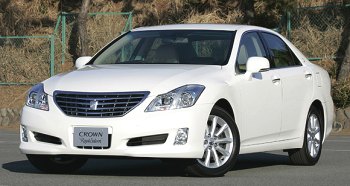
|
The nameplate might be more than 50
years old, but it looks younger than ever in the 13th generation...
|
This year
Crown has
entered the 13th generation. Its family now consists of six models:
Royal, Athlete, Hybrid, Majesta, Sedan and Comfort. Let me introduce
one by one. Royal is traditionally the best selling Crown, as it is
comfort-oriented. Athlete is the sportier version as we have mentioned.
Hybrid is self-explained. Majesta is the most luxurious version and the
only one powered by a V8 engine, but its position is being replaced by
Hybrid, so Toyota actually leaves the Majesta unchanged from the last
generation. Expect it will phase out soon. Crown Sedan has a silly name
which explains nothing. It is actually another car based on a very old
and low-cost architecture. It targets at government car and police car
market. Its even cheaper version is Crown Comfort, which is designed to
serve as taxi. By the way, all taxis in Hong Kong are Crown Comfort.
Therefore
when we talk
about the 13th generation Crown, only Royal, Athlete and Hybrid are
qualified. Compare with the last generation, they look younger and more
stylish. The front grille is no longer conservative. The headlamps are
shaped more radically. The front bumper is more stylish. The base of
the A-pillars is brought forward and the windscreen is faster angled,
so the overall profile becomes smoother and faster. The front fenders
are more sculpted, like various Mazdas, to deliver a sportier image. In
contrast, the tail design is less successful - too square and the
taillights oddly shaped. Overall speaking this is the handsomest Crown
I have ever seen, but it still lacks a unique character that we have
found in BMW, Audi, Mercedes, Volvo, Jaguar, Cadillac...
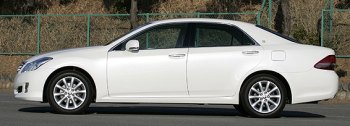
|
13th generation Crown continues to
base on the old platform...
|
Despite of the
name
"new generation", the platform underpinning it is actually carried over
from the last generation, thus its siblings continue to be Lexus GS and
Toyota Mark X. The 2850mm wheelbase is unchanged from the old car.
Length, width and tracks are increased by merely 30mm, 15mm and 10mm
respectively. Kerb weight is increased by around 40 kg.
The cabin of the previous Crown majored on a comfortable and inviting
theme. In contrast, the new cabin is designed to look cool and sporty.
An angular console is matched with dark plastics (soft-touch of
course), dark woods, dark stitched leather trim and even faux
carbon-fiber trim. A classy new feature to the Hybrid model is a TFT
LCD instrument panel, which can display analogue or digital
speedometers and other information, very much like Mercedes S-class.
The control panel on center console faces slightly upward for better
ergonomics.
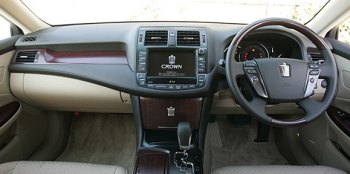
|
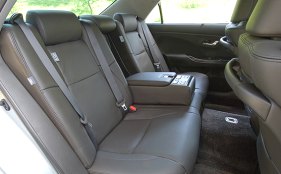
|
Interior gets dark and cool
|
As usual,
space is
abundant for all passengers, especially the rear. The boss sitting
there is served with independent climate control (with ozone air
purifier), massaging seats, refrigerator, a center armrest with audio
control and additional air vents on the roof. He may also rest
his legs on the front seat cushion once the center section of the
seatback folds down. Loyal customers of Crown are no strangers to these
features, as they were already adopted in the previous generation.
New safety features include:
- A
Mercedes-style Pre-Crash safety system, which detects possible
collision with microwave radar and then activates alarm, gentle braking
while tightening seat belts;
- A driver
monitoring system
similar to the one in Lexus LS600h, which detects the driver's right
eye to see if he fall
asleep or lose concentration, then try to get his mind back;
- An
infrared
Night View system, which displays thermal image of the road to the TFT
LCD instrument screen on Crown Hybrid, again very much like Mercedes
S-class.
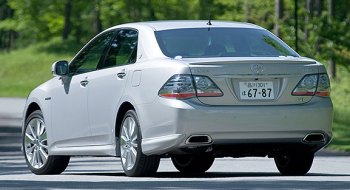
|
Crown Hybrid is powered by the same
propulsion system as Lexus GS450h...
|
The new Crown
is
offered with 4 engines. Royal continues to use the outgoing car's 215hp
2.5-liter V6 and 256hp 3.0-liter V6. Considering they already employ
dual-VVT-i and D-4 direct fuel injection, and their BMW-matching
efficiency, we should have no complaints. Both engines now mate with a
6-speed automatic gearbox.
The sportier Athlete is available with that 3.0 engine plus a new
3.5-liter V6 from Lexus GS350, which has dual-mode injection (port
injection + direct injection). It produces an excellent 315 horsepower
and 278 lb-ft of torque. This finally gives the Athlete a very athletic
performance. Expect 0-60 mph in less than 6 seconds.
The last engine is Toyota's THS II hybrid power unit, comes directly
from Lexus GS450h. It combines the aforementioned 3.5 V6 and a pair of
electric motors, one for propulsion and another for recharging. The
combination of motor and engine provides 345 horsepower and especially
very strong torque at low rev. Unlike the mild hybrid system used in
the previous Crown, this is a full hybrid. In other words, it can run
purely in electric mode, as the motor alone produces some 200
horsepower. However, the extra 180 kg it carries (due to the motors and
battery pack) does handicap its handling, so it is more an eco showcase
than a real driver's car.
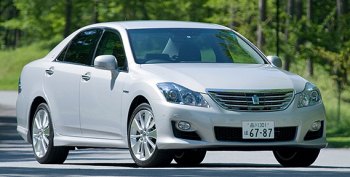
|
The best driver's car in the lineup is
not this Hybrid, but the Crown Athlete...
|
None of the
Crowns
are real driver's cars actually, but thanks to its stiffer suspensions,
the Athlete comes closest. Closer than we expected actually. Imagine a
Lexus GS350 with stiffer suspension setup, trading some ride quality
with tighter body control, and this is how the Crown Athlete feels
like. The specifications of its chassis is more or less the same as the
previous generation. Features like double-wishbones and multi-link
suspensions, AVS adaptive damping and VDIM stability control are
carried over with fine tuning. New additions are VGRS variable ratio
steering and a driver-selectable control system with Sport, Eco and
Snow mode which alter engine mapping, suspension stiffness and steering
weighting. But these electronic aids do no much help to driving
satisfaction. What really improved the Crown Athlete was the effort
spent to testing and tuning its ride and handling. In recent years
Toyota gets more serious in testing and upgraded its proving grounds to
simulate challenging roads. This shows in the way its new cars ride and
handle.
Recently I watched a video in which the Japanese put a Crown Athlete
3.5 against a BMW 530i on race track. The Crown surprised many by
beating the BMW in a lap. Although this is mostly down to its more
powerful engine (assuming if it face a 535i, the result will be very
different), the Crown showed good handling in the video, and its lap
time proved that it is more than a powerful engine. However, the
weakest link in its dynamic spectrum is the steering, which is tuned to
be too light (to please matured Japanese executives) and too numb (as
it is electrically assisted).
Steering aside, the 13th generation Crown exceeds my expectation on the
car. If Toyota decide to export it, it could have a decent fight with
the global players. Image-wise, it still lacks a clear identity. You
know what Lexus GS stands for, but you can hardly tell what Toyota
Crown is. Its various family models confuse us whether it is a comfort
luxury car, a sporty premium car, a no-nonsense company car or a taxi.
Perhaps it has too much historic burdens to carry.
|
| The
above report was last updated on 7 Jul 2008. All Rights Reserved. |
|
Crown Majesta
|

|
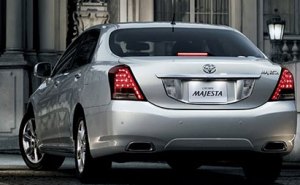
|
Since its emergence in
1991, Majesta has always been the flagship model of the Crown family.
Not only being the most luxuriously equipped, it is the only Crown
powered by a V8 engine. You know, a V8 is so much more graceful than a
V6 to rich customers. It is what lifts a luxury car from an executive
car, what separates the CEOs from executives, and in the case of Crown,
what differs Majesta from Royal.
To outsiders, Crown Majesta seems an unnecessary creation provided the
existence of Lexus LS460 and GS460. However, in Japan the super Crown
does have a niche survival space. This is because the Lexus brand is
relatively new to the domestic market, therefore it attracts mostly
forward-thinking individual customers. In contrast, Crown is still the
majority choice for company car purchasing, thanks to the reliable and
conservative image it established for decades. As a result, Toyota
continues updating the Crown Majesta to take care of its traditional
company car customers, which are expected to account for 70 percent of
its total sales.
Previously, Crown Majesta differed from other Crown models by mostly
the engine, equipment level and a slight facelift. The latest
generation is much more generous. It shares virtually no body panels
with other Crowns because it is both longer (by 115mm) and wider
(by15mm). Its wheelbase has been stretched from the regular car's
2850mm to 2925mm, deliberating more legroom for the boss at the back
seat. In terms of interior space, it sits between Lexus GS and LS.

|
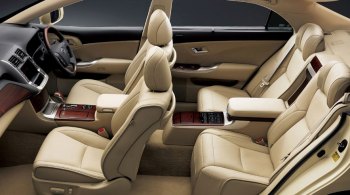
|
The top Crown
serves its rear seat passengers much better than the regular car. For a
starter, it has two individual boss chairs instead of a bench seat.
Each of them provides a leg rest, and each can recline electrically. In
case of a predicted collision, the seatbacks will straight up
automatically to protect the occupants. Locating between the rear seats
is a center console which incorporates audio control, climate control
and drink cooler. As a first for Toyota, the left and right rear seats
have climate controls independent of each other, so everybody should
feel comfortable.
The 4608cc V8 is detuned version of the one serving LS460. It features
electrical dual-VVT-i and direct fuel injection. Huge power is hardly
useful on Japanese roads, so its output is scaled back to 347
horsepower and 339 pound-foot of torque, the same as GS460. Curiously,
it is no more powerful than the Crown Hybrid, but it delivers superior
smoothness and quietness in a stress-free manner. Also coming from its
Lexus siblings is the seamless 8-speed automatic gearbox. You may call
the Crown Majesta a "poor man's LS460" or "lazy man's GS460".
Predictably, the driving manner of this car is more about comfort than
excitement, unlike Crown Athlete. Its adaptive damping is now linked to
the satellite navigation, taking advantage of the known information of
road ahead to preset the suspension stiffness. The excess weight and
wheelbase means it is not as agile as Crown Athlete or Lexus GS460, but
I think that is the least worrying thing to its target customers. They
do care about safety though. Drowsy detection and warning, night vision
infrared camera (with pedestrian detection) and the world's first
center rear seat air bag – which prevents the two rear passengers from
colliding with each other in rebound – should satisfy their needs.
Crown Majesta is unquestionably a safe luxury car, but it is not a very
interesting one.
|
| The
above report was last updated on 21 Jan 2010. All Rights Reserved. |
| Specifications
|
| General remarks |
| Layout |
| Chassis |
| Body |
| Length / width / height |
| Wheelbase |
| Engine |
| Capacity |
| Valve gears |
| Induction |
| Other engine features |
Max power
|
Max torque
|
| Transmission |
Suspension layout
|
| Suspension features |
| Tires |
| Kerb weight |
| Top speed |
| 0-60 mph (sec) |
| 0-100 mph (sec) |
|
| Crown Royal 3.0 |
Front-engined, RWD
|
| Steel monocoque |
| Mainly steel |
| 4870 / 1795 / 1470 mm |
| 2850 mm |
V6, 60-degree
|
| 2994 cc |
DOHC 24 valves, DVVT
|
| - |
| DI |
256 hp
|
232 lbft
|
| 6-speed automatic |
F: double-wishbone
R: multi-link
|
| Adaptive damping |
| 215/55VR17 |
| 1630 kg |
| - |
| - |
| - |
|
| Crown Athlete 3.5 |
Front-engined, RWD
|
| Steel monocoque |
| Mainly steel |
| 4870 / 1795 / 1470 mm |
| 2850 mm |
V6, 60-degree
|
| 3456 cc |
DOHC 24 valves, DVVT
|
| - |
| DI |
315 hp
|
278 lbft
|
| 6-speed automatic |
F: double-wishbone
R: multi-link
|
| Adaptive damping |
| 225/45WR18 |
| 1660 kg |
| - |
| - |
| - |
|
| Crown Hybrid |
Front-engined, RWD
|
| Steel monocoque |
| Mainly steel |
| 4870 / 1795 / 1470 mm |
| 2850 mm |
V6, 60-degree, electric motor
|
| 3456 cc |
DOHC 24 valves, DVVT
|
| - |
| DI |
296 hp (engine)
200 hp (motor)
345 hp (combined)
|
278 lbft (engine)
203 lbft (motor)
|
| E-CVT |
F: double-wishbone
R: multi-link
|
| Adaptive damping |
| 225/45WR18 |
| 1840 kg |
| - |
| - |
| - |
|
| General remarks |
| Layout |
| Chassis |
| Body |
| Length / width / height |
| Wheelbase |
| Engine |
| Capacity |
| Valve gears |
| Induction |
| Other engine features |
Max power
|
Max torque
|
| Transmission |
Suspension layout
|
| Suspension features |
| Tires |
| Kerb weight |
| Top speed |
| 0-60 mph (sec) |
| 0-100 mph (sec) |
|
| Crown Majesta |
Front-engined, RWD
|
| Steel monocoque |
| Mainly steel |
| 4995 / 1810 / 1475 mm |
| 2925 mm |
V8, 90-degree
|
| 4608 cc |
DOHC 32 valves, DVVT
|
| VIM |
| DI |
347 hp
|
339 lbff
|
8-speed automatic
|
F: double-wishbone
R: multi-link
|
| Adaptive damping |
| 235/50VR17 |
| 1820 kg |
| - |
| - |
| - |
|
|
|
|
| Performance
tested by: - |
Copyright©
1997-2010
by Mark Wan @ AutoZine
|
|
|









